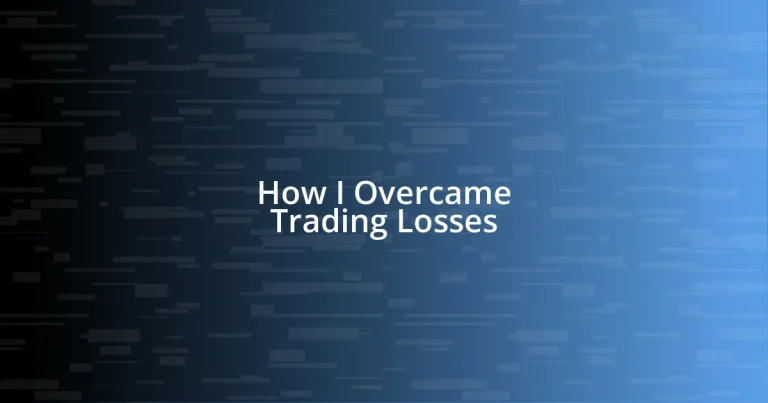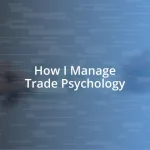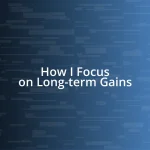Key takeaways:
- Resilience through losses: Transform setbacks into learning opportunities, strengthening emotional responses and decision-making skills.
- Implementing risk management: Establish clear strategies like setting stop-loss orders and diversifying investments to safeguard against substantial losses.
- Creating a personal trading plan: Outlining a structured approach, incorporating backtesting, and maintaining flexibility to adapt to market changes enhances trading effectiveness.
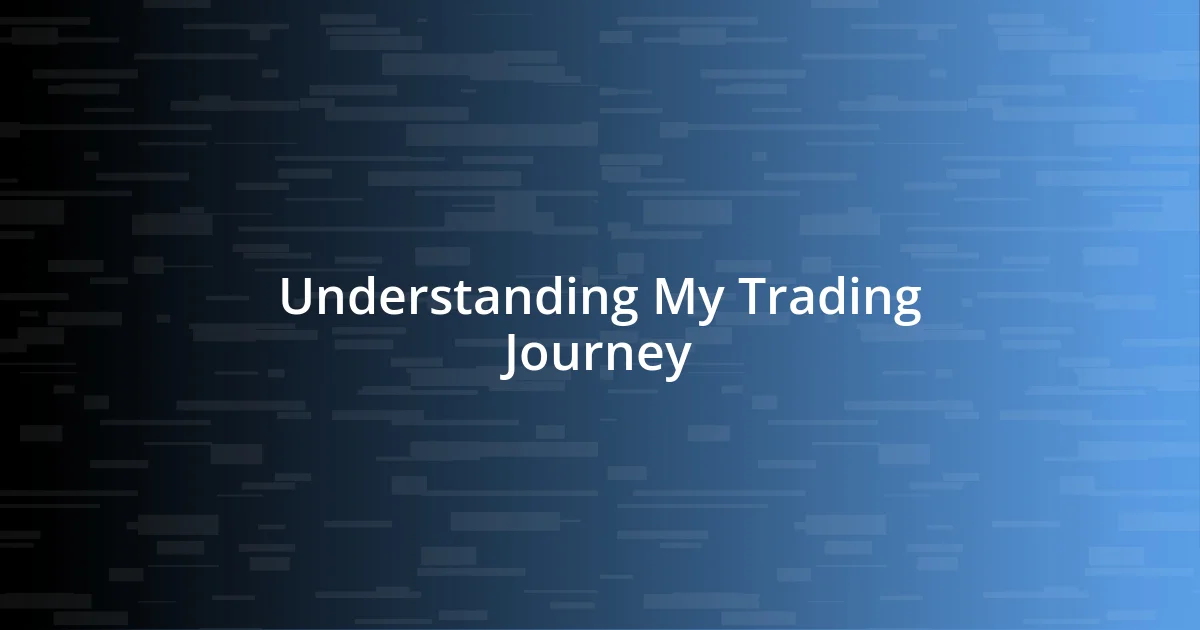
Understanding My Trading Journey
My trading journey has been anything but straightforward. I remember the thrill of making my first successful trade; it felt like I had struck gold. Yet, as quickly as the joy came, so did the inevitable losses. It’s almost funny when I think about it—how a single bad trade could wipe out hours of careful planning. How could I be so blindsided?
Looking back now, I realize that each setback was a lesson in disguise. I had moments where I felt like quitting, staring at my screen with a mix of frustration and disbelief. But it was in those tough times I learned the importance of resilience. I often asked myself, “What can I learn from this?” This simple shift in perspective sparked a change in my approach that I never anticipated.
I still vividly recall sitting in my home office one rainy afternoon, feeling utterly defeated. Instead of wallowing, I decided to dive into analysis and educate myself more about risk management. That pivotal moment propelled me forward and made me realize—trading isn’t just about winning; it’s about continuous growth and adaptation. Embracing that mindset transformed my relationship with trading.
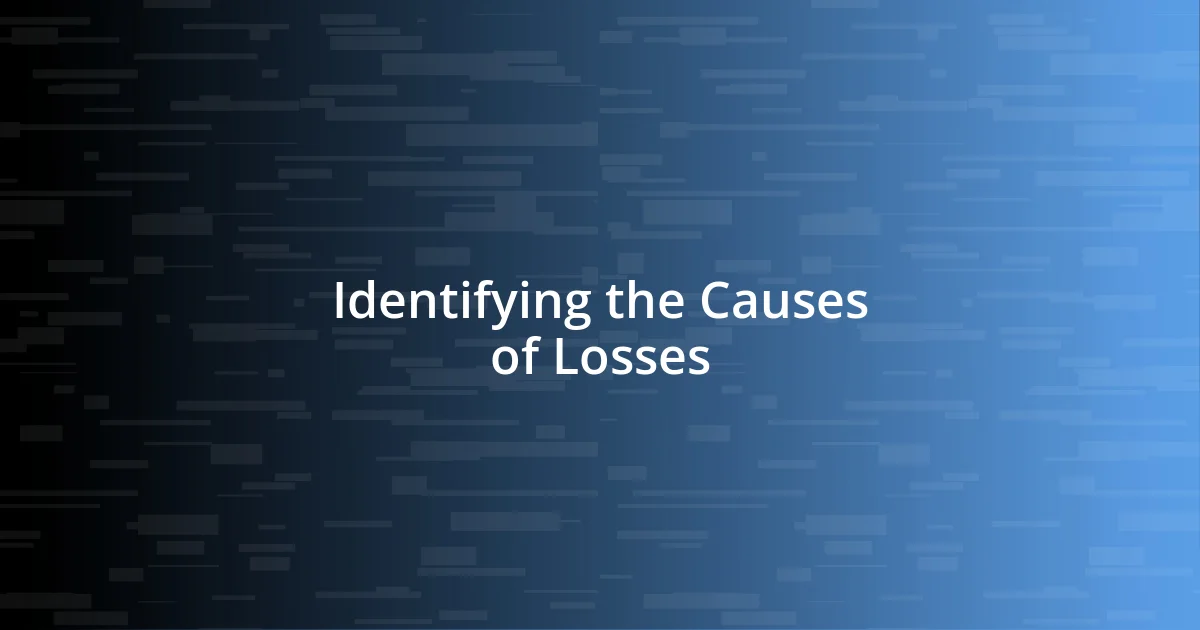
Identifying the Causes of Losses
Identifying the causes of trading losses is a vital step in the journey to becoming a successful trader. I remember sitting at my desk late one night, feeling the weight of my recent losses pressing down on me like a heavy blanket. I opened my trading journal and scoured my entries, looking for patterns. That introspection led me to recognize some common themes: poor risk management, emotional decision-making, and a lack of thorough analysis.
Here are some key causes I identified during my journey:
- Overtrading: I sometimes traded too frequently, hoping to recover losses quickly, which often led to deeper pitfalls.
- Chasing losses: I’ve been guilty of trying to make back lost money by making riskier trades, only to lose even more.
- Ignoring stop-loss orders: Many times, I let my emotions dictate my decisions instead of adhering to my plan, which resulted in unnecessary losses.
- Poor market research: I’ve also jumped into trades without proper analysis, driven solely by tips or rumors.
- Lack of a clear strategy: Failing to have a well-defined trading strategy has led me to make impulsive decisions and ultimately, losses I could have avoided.
Retracing my steps and understanding these elements helped me adapt and ultimately improve my trading performance.
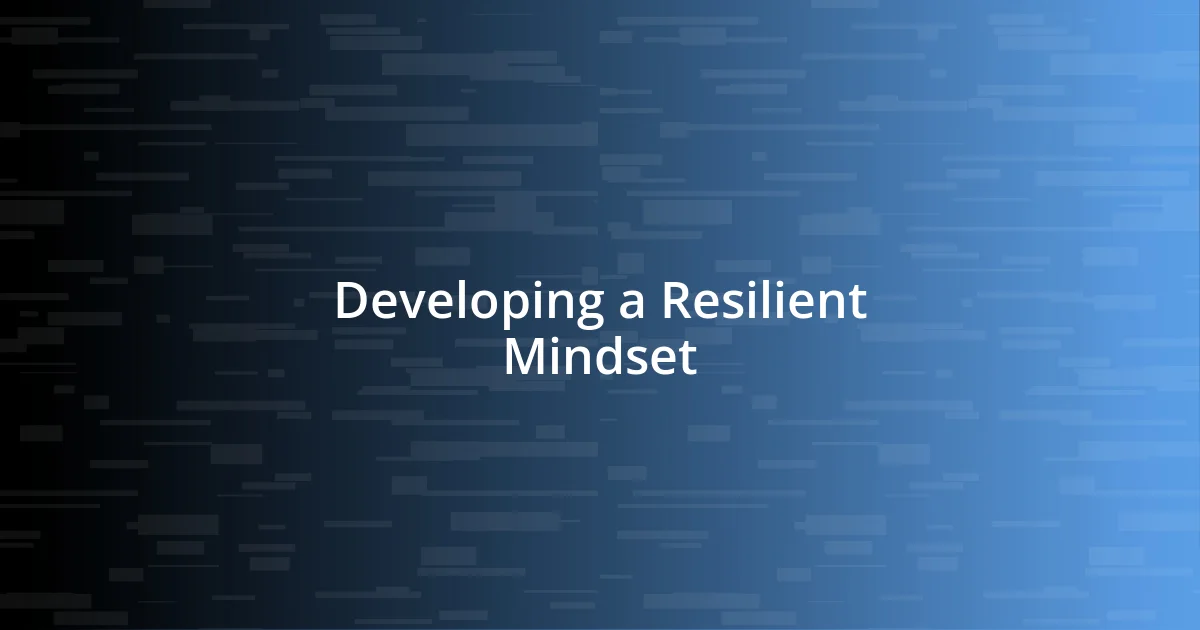
Developing a Resilient Mindset
Developing a resilient mindset in trading is essential. I’ve been there—feeling the anxiety creep in when facing a significant loss. One of the most effective strategies I found was focusing on my emotional responses to these challenges. Instead of succumbing to fear, I learned to embrace my discomfort as an opportunity to grow. Reflecting on my feelings turned them into fuel for improvement. It’s remarkable how a simple mindset shift can transform devastation into motivation.
Another lesson I’ve drawn on is the importance of patience. After experiencing numerous losses, I felt the urge to force recovery, but that only compounded my mistakes. I began to realize that successful trading isn’t just about making quick decisions; it’s about cultivating a sense of calm and resistance to pressure. I remember one particularly stressful day when I took a step back, went for a short walk, and cleared my mind. Returning to my desk with fresh eyes allowed me to reevaluate my strategy and make sound decisions instead of emotional ones.
Lastly, I found it helpful to build a support network around me. Sharing my experiences with fellow traders made me feel less isolated in my struggles. One evening, a friend and I had a late-night chat about our losses, and it struck me how connected we are through our challenges. Support can come from unexpected places, and encouragement from others can be a counterbalance to self-doubt that often accompanies trading losses. I learned that resilience is not just about fighting alone; it’s about leaning on the community too.
| Mindset Focus | Impact on Trading |
|---|---|
| Embracing discomfort | Transforms fear into motivation |
| Practicing patience | Encourages sound decision-making |
| Building support networks | Reduces feelings of isolation |
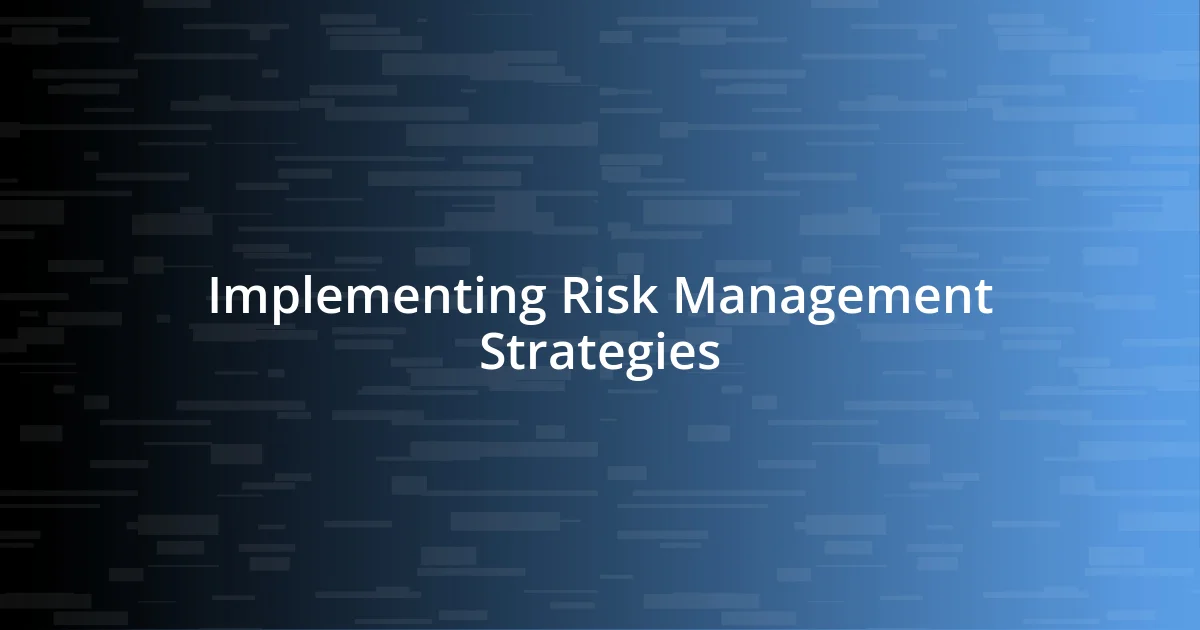
Implementing Risk Management Strategies
Implementing risk management strategies has been a game changer for me. I recall a particularly turbulent period when I found myself dangerously overleveraged. One night, as I stared at the fluctuating numbers on my screen, I realized I should have set a maximum loss limit for each trade. Implementing that limit now makes my trading feel like a safety net, rather than a tightrope act, allowing me to trade with confidence.
Another strategy that significantly transformed my approach was the placement of stop-loss orders. Initially, I hesitated to use them, thinking they would restrict my potential gains. But after a few harsh lessons, I understood that they serve as crucial safeguards against emotional decision-making. I remember a trade that went south quickly—I had set a stop-loss, and it triggered just in time to minimize my losses. Reflecting on that moment, I felt a wave of relief, realizing that I had protected my capital while maintaining the discipline I knew was necessary for long-term success.
Lastly, diversifying my portfolio has become a cornerstone of my risk management plan. In the past, I would concentrate my investments in a few assets, often leading to devastating outcomes when those assets underperformed. I still feel the sting of one specific instance where I lost significantly. When I finally diversified, choosing to spread my investments across different sectors, it was a revelation. Not only did it balance my risk, but it also provided me with a sense of control and security. Have you ever felt the relief of knowing that not all your eggs are in one basket? That’s precisely what diversifying has done for me—it’s shifted my perspective from fear of loss to embracing the journey of trading.

Learning from Each Trade
Learning from each trade has been a pivotal aspect of my trading journey. Every loss carries a lesson, and I’ve made it a habit to analyze my trades meticulously. I remember one time when I was convinced a particular asset would rally. Instead, it tanked, and I was left scratching my head. It hit me then—understanding my reasons for entering that trade was crucial. Did I rely too heavily on a gut feeling rather than data? By breaking down my thought process, I’ve become more aware of my biases and improved my decision-making skills.
There’s something deeply enlightening about maintaining a trading journal. After my most challenging days, I would sit down with a cup of tea and pen my reflections. It’s fascinating to revisit those entries; they reveal patterns I hadn’t noticed while in the thick of it. I often ask myself: what emotions drove my decisions, and how can I manage them better next time? This practice not only calms my nerves but also transforms past mistakes into stepping stones for future success.
Engaging with my trading community has also brightened my understanding. Chatting about our trades, both victorious and tragic, has opened my eyes to alternative perspectives. I once joined a discussion where someone shared a similar mistake I made, prompting an “aha” moment for me. Their insight led me to question how much I truly value market news versus price action. Learning from others’ experiences has enriched my journey, turning trading losses into invaluable education. Aren’t we all just trying to navigate this complex landscape together? It’s these shared moments that can make all the difference.

Setting Realistic Trading Goals
Setting realistic trading goals has often been my first line of defense against the emotional rollercoaster that trading can evoke. In the early days, I set lofty expectations, aiming for sky-high profits every month. But after facing despair from disappointments, I realized that short, incremental goals focused on consistency were far more effective. What’s the point of aiming for the stars if it only leads to frustration when I miss? By breaking my goals down into smaller, achievable targets, I’ve felt a renewed sense of motivation and clarity.
I also learned to align my trading goals with my personal life and emotional well-being. Balancing the thrill of trading with real-life commitments is key. I remember a phase when I pushed myself to trade excessively, thinking more hours would mean more success. Spoiler alert: it didn’t. I was burnt out and snappy with family and friends. I quickly understood that setting boundaries—like specifying not to trade after a long day—has enriched my trading journey and preserved my mental health. How do we strike that balance between ambition and well-being? It turns out, creating space for rest can be just as important as hitting those trade targets.
Moreover, embracing the reality of losses as a part of the trading process has fostered resilience in me. I vividly recall a trade that went horribly wrong; I had aimed for a specific return but instead faced considerable loss. Initially, it felt like a blow to my confidence. But reflecting on that moment, I learned to set my goals with room for accepting losses. How liberating it is to realize that setbacks don’t define my journey—they’re stepping stones. With this perspective, I’ve been able to approach trading with a long-term mindset, leading to sustainable growth. So, what becomes of our trading when we accept losses as part of the game rather than its conclusion? It becomes a chance to evolve.
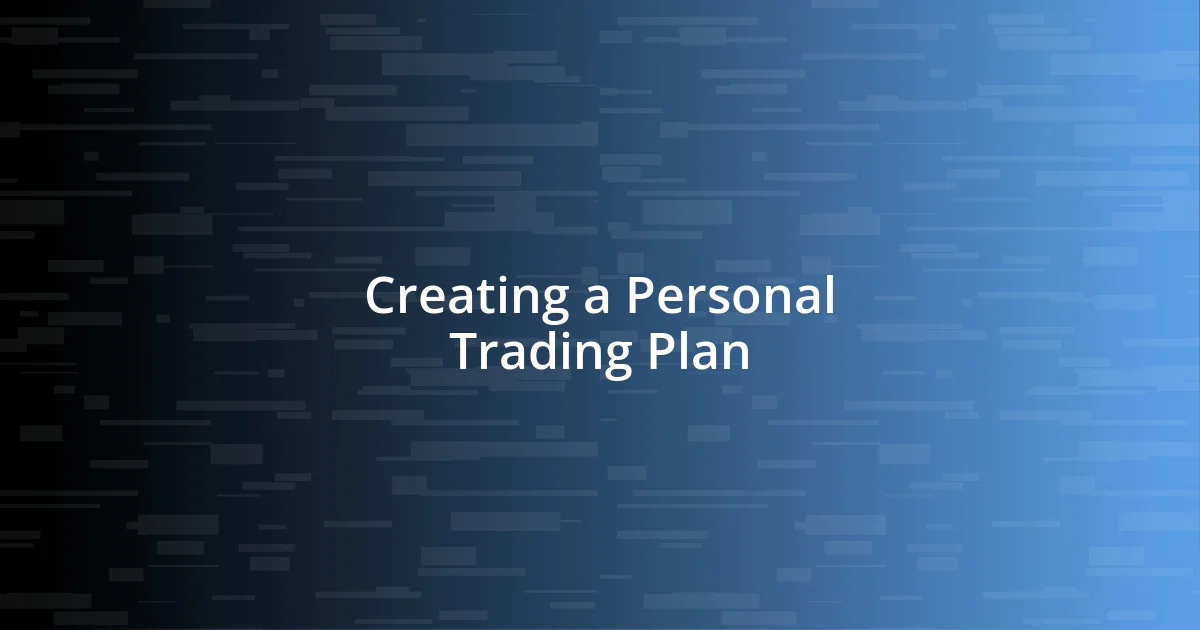
Creating a Personal Trading Plan
Creating a personal trading plan has been a transformative experience for me. Initially, my approach was quite chaotic—I dove into trades based on haphazard strategies. Eventually, I understood that outlining a clear plan before executing any trade was essential. I recall crafting my first detailed trading plan on a sunny afternoon, sipping coffee. It felt empowering to have my thoughts organized in one place; I listed my risk tolerance, entry and exit strategies, and the indicators I would consult. This framework served as my guiding light, especially during turbulent market days.
A pivotal moment came when I started incorporating backtesting into my plan. It’s like having a time machine, allowing me to review past trades to see how well my strategies would have performed. The results were eye-opening! I found that not all strategies worked across different market conditions. I remember a time when a particular setup looked promising on paper, but the backtest revealed a series of lost trades. If I hadn’t gone through that process, I might have jumped in blindly. It raised a question for me: how much do we really know our strategies until we’ve tested them? Now, I can confidently say that backtesting has made me more disciplined and patient in my trading approach.
Lastly, I’ve learned the importance of flexibility in my trading plan. The market is unpredictable and can change faster than we expect. I once held onto a trade longer than I should have, anchored by my original analysis. It felt like watching a friend make a terrible decision but being helpless to stop them. Lesson learned: I now revisit and adjust my trading plan regularly, ensuring it aligns with current market conditions and my evolving goals. Being adaptable is empowering and ensures that my plan remains relevant. After all, isn’t it vital for a trader to evolve just as the markets do?












